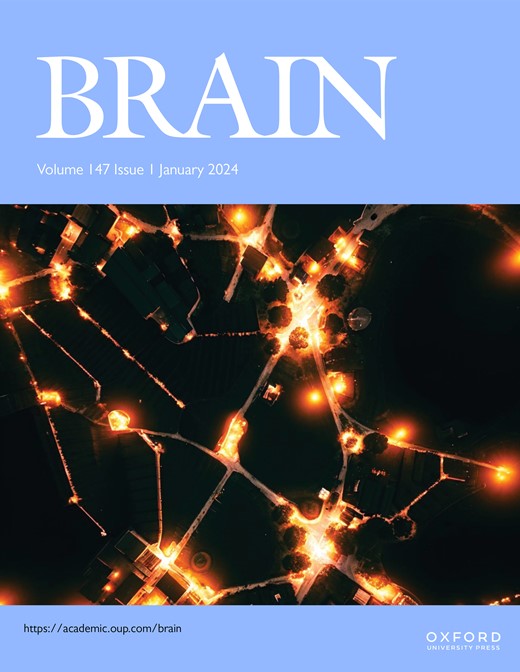SLC35A2 loss-of-function variants affect glycomic signatures, neuronal fate and network dynamics
IF 10.6
1区 医学
Q1 CLINICAL NEUROLOGY
引用次数: 0
Abstract
SLC35A2 encodes a UDP-galactose transporter essential for glycosylation of proteins and galactosylation of lipids and glycosaminoglycans. Germline genetic SLC35A2 variants have been identified in congenital disorders of glycosylation and somatic SLC35A2 variants have been linked to intractable epilepsy associated with malformations of cortical development. However, the functional consequences of these pathogenic variants on brain development and network integrity remain unknown. In this study, we use an isogenic human induced pluripotent stem cell-derived neuron model to comprehensively interrogate the functional impact of loss of function variants in SLC35A2 through the integration of cellular and molecular biology, protein glycosylation analysis, neural network dynamics, and single cell electrophysiology. We show that loss of function variants in SLC35A2 result in disrupted glycomic signatures and precocious neurodevelopment, yielding hypoactive, asynchronous neural networks. This aberrant network activity is attributed to an inhibitory/excitatory imbalance as characterization of neural composition revealed preferential differentiation of SLC35A2 loss of function variants towards the GABAergic fate. Furthermore, electrophysiological recordings of synaptic activity and gene expression differences suggest network phenotypes are driven by changes occurring at the synapse. Our study is the first to provide mechanistic insight regarding the early development and functional connectivity of SLC35A2 loss-of-function variant harboring human neurons, providing important groundwork for future exploration of potential therapeutic interventions.SLC35A2功能丧失变体影响糖基特征、神经元命运和网络动力学
SLC35A2编码一种udp -半乳糖转运蛋白,对蛋白质的糖基化、脂质和糖胺聚糖的半乳糖基化至关重要。生殖系遗传SLC35A2变异已在先天性糖基化疾病中被发现,体细胞SLC35A2变异与皮质发育畸形相关的顽固性癫痫有关。然而,这些致病变异对大脑发育和网络完整性的功能影响尚不清楚。在这项研究中,我们通过细胞和分子生物学、蛋白糖基化分析、神经网络动力学和单细胞电生理学的整合,使用一个等基因的人诱导多能干细胞衍生的神经元模型,全面探讨SLC35A2功能变异缺失对功能的影响。我们发现SLC35A2功能变异的缺失会导致糖基特征的破坏和神经发育的早熟,从而导致神经网络不活跃、不同步。这种异常的网络活动归因于抑制性/兴奋性失衡,因为神经组成的表征揭示了SLC35A2功能丧失变异向gaba能命运的优先分化。此外,突触活动和基因表达差异的电生理记录表明,网络表型是由突触发生的变化驱动的。我们的研究首次提供了包含人类神经元的SLC35A2功能丧失变体的早期发育和功能连接的机制见解,为未来探索潜在的治疗干预措施提供了重要的基础。
本文章由计算机程序翻译,如有差异,请以英文原文为准。
求助全文
约1分钟内获得全文
求助全文
来源期刊

Brain
医学-临床神经学
CiteScore
20.30
自引率
4.10%
发文量
458
审稿时长
3-6 weeks
期刊介绍:
Brain, a journal focused on clinical neurology and translational neuroscience, has been publishing landmark papers since 1878. The journal aims to expand its scope by including studies that shed light on disease mechanisms and conducting innovative clinical trials for brain disorders. With a wide range of topics covered, the Editorial Board represents the international readership and diverse coverage of the journal. Accepted articles are promptly posted online, typically within a few weeks of acceptance. As of 2022, Brain holds an impressive impact factor of 14.5, according to the Journal Citation Reports.
 求助内容:
求助内容: 应助结果提醒方式:
应助结果提醒方式:


